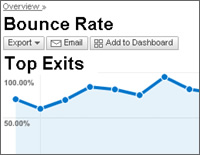 Over the past year, I’ve received more and more questions about two important metrics in web marketing, Bounce Rate and Exit Rate. It seems there is some confusion about differences between the two, why they are important, what they tell you, and how to improve them. So, I decided to write this post to demystify them a bit.
Over the past year, I’ve received more and more questions about two important metrics in web marketing, Bounce Rate and Exit Rate. It seems there is some confusion about differences between the two, why they are important, what they tell you, and how to improve them. So, I decided to write this post to demystify them a bit.
The Definition of Bounce Rate and Exit Rate
Let’s start with some definitions. The definition of Bounce Rate is the percentage of visitors that hit your website on a given page and don’t visit any other pages on your site. For example, John views an organic search listing, clicks through to your site, and then leaves your site without visiting any other pages. He bounced. You can learn more about lowering your bounce rate here.
Note: If you’re a small business looking to learn more about web analytics, then you should check out my internet marketing ebook, Taking Control of Your Online Marketing. There’s an entire chapter on Web Analytics covering the setup, installation, sections of reporting, how to track conversion, events, etc. It’s a great place to start.
The definition of Exit Rate is the percentage of visitors that leave your site from a given page based on the number of visits to that page (or pageviews in some cases). Sounds similar to Bounce Rate, doesn’t it? There’s a difference, though. The visitor who exits might have visited other pages on your site, but just exited on that specific page. For example, John views an organic search listing, clicks through your site, reads a blog post, then clicks the About Us link. After finding out more about your company, John clicks the contact us link and fills out a contact form. He then exits your site. The contact us page is where he exited. In contrast, if he simply visited the site via organic search and left without visiting any other page, it would have been a bounce. Make sense?
Why are Bounce Rate and Exit Rate Important?
Both metrics are important in web analytics and can help online marketing people glean insights from the data, but they are definitely used differently. Bounce Rate is extremely important for determining how your landing pages perform as compared to visitor expectations. For example, if you run paid search campaigns, then you know the importance of testing a landing page (optimizing the landing page). I find that bounce rate at the aggregate level doesn’t tell you very much (site level bounce rate), but I find that bounce rate at the page level is extremely useful. It actually makes a lot of sense if you think about it. For example, if you are driving paid search visitors to your landing page selling Coffee Makers {OK, it’s 5AM and I’m tired :-)}, and you have a 70% Bounce Rate on that page, you’ve got a problem. Why are that many visitors bouncing after clicking through your paid search ad and landing on a page that theoretically should be highly targeted? This is actually the fun part…digging into the data, optimizing the page, and using multivariate testing to lower your bounce rate and to increase conversion. As you can see, bounce rate can help you determine how well your landing pages perform (which directly affects revenue and ROAS).
In my opinion, Exit Rate is more important for determining which page in a process isn’t performing up to expectations. For example, if you have mapped out scent trails on your site (ala Persuasion Architecture), and you find visitors are exiting the site on a webpage that clearly is a stepping stone to a more important page, then you should probably take a hard look at that page’s content. Are the calls to action not compelling enough? Does the page provide content that throws off visitors? Is there a technical issue with the page? Does it take too long to load? So on and so forth. Note, that for specific processes like cart checkout, you should use funnel analysis, but analyzing exit rate for more open ended processes works well (like targeting a type of buyer and providing a scent trail for them to get to a registration form.)
Different Yet Important
As you can see, both metrics are very different, but both are important. My recommendation is to start analyzing Bounce Rate and Exit Rate for key pages and processes on your site. I would begin with a focused effort, like a landing page that receives a lot of paid search traffic (for Bounce Rate) and possibly a lead generation process on the site for Exit Rate (if you have one). I won’t cover the process of optimizing your content in this post, but you can read an introduction to multivariate testing using Google Website Optimizer to learn more about website testing. I believe multivariate testing is a critical component to increasing conversion and lowering bounce rate for your key landing pages. It can help you increase revenue without adding one more new visitor to your site. Intriguing, isn’t it? :-)
In closing, who thought that bouncing and exiting would be an interesting topic in marketing? ;-) Addressing Bounce Rate and Exit Rate can help you meet customer expectations, which can lead to higher conversion rates (whether that means sales, registrations, RSS subscriptions, etc.) There is one more point worth mentioning… although you can learn a lot from both Bounce Rate and Exit Rate, don’t forget about qualitative data. During your optimization process, ASK YOUR CUSTOMERS AND VISITORS about your key landing pages via surveys, focus groups, phone calls, etc. You may be too close to the content to see what’s wrong and you would be amazed to read and hear what actual visitors have to say.
GG
